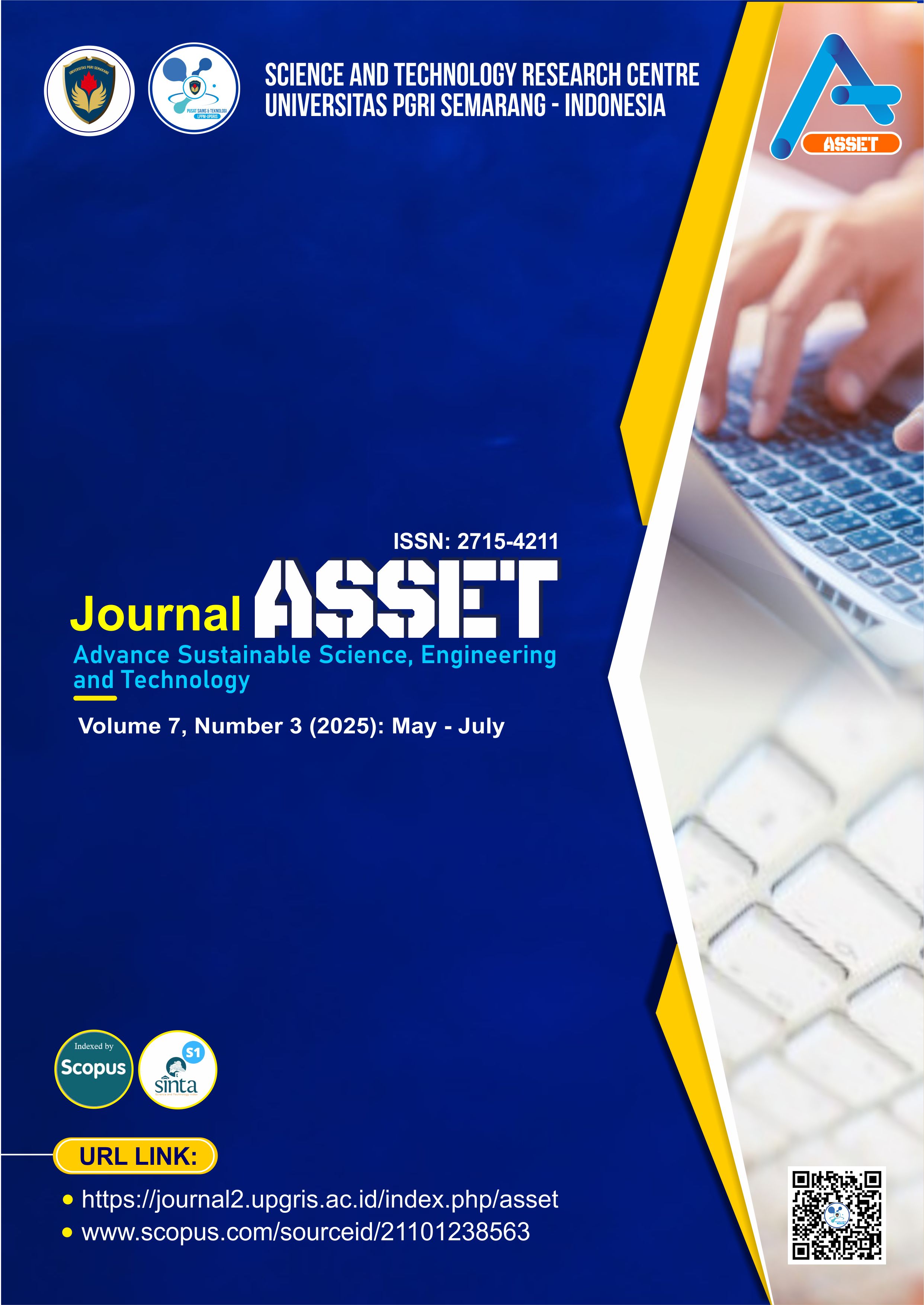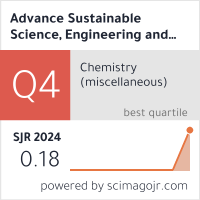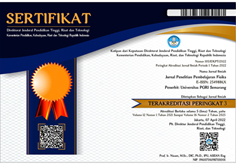Hydrogeochemical Characterization and Subsurface Flow Analysis of Volcanic Hot Springs
DOI:
https://doi.org/10.26877/asset.v7i4.1818Keywords:
Geothermal system, Hydrogeochemistry, Volcanic hot springs, Subsurface flowAbstract
Understanding of the hydrogeochemical system of volcanic hot springs in Tompaso, Minahasa, is still limited, especially regarding the origin of water and subsurface flow patterns. This study aims to classify geothermal water types and analyze groundwater flow systems in volcanic environments. A total of 15 hot spring samples were analyzed using field measurements (temperature, pH, electrical conductivity), ion chromatography, titration, and spectrophotometry. Data validation was done with ion balance, and water classification using Piper diagrams. The results showed four main types of water, namely Mg-SO₄, H-SO₄, Na-Cl, and Na-SO₄. Most of the samples are from meteoric water directly heated by the geothermal system, while two samples (HT-11A and HT-11B) were heated by steam. These findings provide a scientific basis for sustainable geothermal exploration and groundwater conservation in volcanic areas with variable geothermal systems at the study site
References
[1] G. Axelsson, “The future of geothermal energy,” in Living with Climate Change, Elsevier, 2024, pp. 397–422. doi: 10.1016/B978-0-443-18515-1.00009-5.
[2] A. Taborda, J. P. Portela, J. Lopez-Sanchez, L. Daniele, D. Moreno, and D. Blessent, “Temperature estimation of the Nevado del Ruiz Volcano geothermal reservoir: Insight from western hot springs hydrogeochemistry,” Journal of Geochemical Exploration, vol. 240, p. 107049, 2022. doi: 10.1016/j.gexplo.2022.107049
[3] B. Y. Idi, A. I. Maiha, and M. Abdullahi, “Spatial mapping and monitoring thermal anomaly and radiative heat flux using Landsat-8 thermal infrared data–A case study of Lamurde hot spring, upper part of Benue trough, Nigeria,” Journal of Applied Geophysics, vol. 203, p. 104654, 2022. doi: 10.1016/j.jappgeo.2022.104654.
[4] E. E. Veloso, D. Tardani, D. Elizalde, B. E. Godoy, P. A. Sánchez-Alfaro, F. Aron, D. Morata, “A review of the geodynamic constraints on the development and evolution of geothermal systems in the Central Andean Volcanic Zone (18–28° Lat. S),” International Geology Review, vol. 62, no. 10, pp. 1294–1318, 2020. doi: 10.1080/00206814.2019.1644678
[5] M. N. A. Anuar, M. H. Arifin, H. Baioumy, M. Nawawi, “A geochemical comparison between volcanic and non-volcanic hot springs from East Malaysia: Implications for their origin and geothermometry,” Journal of Asian Earth Sciences, vol. 217, 104843, 2021. doi: 10.1016/j.jseaes.2021.104843.
[6] X. Zhou, L. Zhuo, Y. Wu, G. Tao, J. Ma, Z. Jiang, J. Cui, “Origin of some hot springs as conceptual geothermal models,” Journal of Hydrology, vol. 624, 129927, 2023. doi: 10.1016/j.jhydrol.2023.129927.
[7] C. Li, X. Zhou, Y. Yan, S. Ouyang, F. Liu, “Hydrogeochemical characteristics of hot springs and their short-term seismic precursor anomalies along the Xiaojiang Fault Zone, Southeast Tibet Plateau,” Water, vol. 13, no. 19, p. 2638, 2021. doi: 10.3390/w13192638.
[8] R. Zhou, X. Zhou, Y. Li, M. He, J. Li, J. Dong, Z. Luo, “Hydrogeochemical and isotopic characteristics of the hot springs in the Litang Fault Zone, Southeast Qinghai–Tibet Plateau,” Water, vol. 14, no. 9, p. 1496, 2022. doi: 10.3390/w14091496.
[9] H. Dong, X. Zhou, M. He, Z. Gao, J. Dong, J. Tian, K. Liu, “Hydrogeochemical characteristics of hot springs in the Daju Fault Zone of the SE Tibetan Plateau, China,” Journal of Asian Earth Sciences, vol. 278, 106398, 2025. doi: 10.1016/j.jseaes.2024.106398.
[10] F. Pirajno, “Subaerial hot springs and near-surface hydrothermal mineral systems past and present, and possible extraterrestrial analogues,” Geoscience Frontiers, vol. 11, no. 5, pp. 1549–1569, 2020. doi: 10.1016/j.gsf.2020.04.001
[11] C. M. Nkinyam, C. O. Ujah, C. O. Asadu, D. V. Kallon, “Exploring geothermal energy as a sustainable source of energy: A systemic review,” Unconventional Resources, 100149, 2025. doi: 10.1016/j.uncres.2025.100149.
[12] S. Goswami and A. K. Rai, “Assessment of hot-springs and geothermal prospects for sustainable energy goals,” Journal of Cleaner Production, p. 145637, 2025. doi: 10.1016/j.jclepro.2025.145637.
[13] A. R. Memon, P. Makauskas, I. Kaminskaite-Baranauskiene, and M. Pal, “Unlocking geothermal energy: a thorough literature review of Lithuanian geothermal complexes and their production potential,” Energies, vol. 17, no. 7, p. 1576, 2024. doi: 10.3390/en17071576.
[14] X. Zhang, Y. Zhang, Y. Li, Y. Huang, J. Zhao, Y. Yi, and D. Zhang, “Geothermal spatial potential and distribution assessment using a hierarchical structure model combining GIS, remote sensing, and geophysical techniques—A case study of Dali’s Eryuan area,” Energies, vol. 16, no. 18, p. 6530, 2023. doi: 10.3390/en16186530.
[15] M. A. Kassem and A. Moscariello, “Advancing sustainable energy: a systematic review of geothermal-powered district heating and cooling networks,” International Journal of Sustainable Energy, vol. 43, no. 1, p. 2417436, 2024. doi: 10.1080/14786451.2024.2417436.
[16] U. Nwaiwu, M. Leach, L. Liu, “Development of an improved decision support tool for geothermal site selection in Nigeria based on comprehensive criteria,” Energies, vol. 16, no. 22, p. 7602, 2023. doi: 10.3390/en16227602.
[17] R. Meirbekova, D. Bonciani, D. I. Olafsson, A. Korucan, P. Derin-Güre, V. Harcouët-Menou, W. Bero, “Opportunities and challenges of geothermal energy: A comparative analysis of three European cases—Belgium, Iceland, and Italy,” Energies, vol. 17, no. 16, p. 4134, 2024. doi: 10.3390/en17164134.
[18] P. Utami, M. Sidqi, Y. Siahaan, M. G. Shalihin, E. E. Siahaan, M. Silaban, “Geothermal Prospects in Lahendong Geothermal Field of the Tomohon–Minahasa Volcanic Terrain (TMVT), North Sulawesi, Indonesia,” Proceedings of the World Geothermal Congress, Apr. 2021.
[19] W. Ngansom, K. Pirarai, and H. Dürrast, “Geological setting and hydrogeothermal characteristics of the Kapong non-volcanic hot spring area in Southern Thailand,” Geothermics, vol. 85, p. 101746, 2020, doi: 10.1016/j.geothermics.2019.101746.
[20] V. Stavropoulou, A. Pyrgaki, E. Zagana, C. Pouliaris, and N. Kazakis, “The Contributions of Tectonics, Hydrochemistry and Stable Isotopes to the Water Resource Management of a Thermal–Mineral Aquifer: The Case Study of Kyllini, Northwest Peloponnese,” Geosciences, vol. 14, no. 8, p. 205, 2024, doi: 10.3390/geosciences14080205.
[21] S. Iswahyudi, I. Permanajati, R. Setijadi, J. A. Zaenurrohman, and M. A. Pamungkas, “The Origin of Geothermal Water Around Slamet Volcano-Paguyangan-Cipari, Central Java, Indonesia,” Journal of Geoscience, Engineering, Environment, and Technology, vol. 5, no. 4, pp. 181–184, 2020, doi: 10.25299/jgeet.2020.5.4.4112.
[22] F. Pinning, A. D. Haryanto, and J. Hutabarat, “Hydrogeochemistry and Isotope Characteristics of the Hot Springs in the Wapsalit Area, Buru Regency, Maluku Province, Indonesia,” Journal of Geoscience, Engineering, Environment, and Technology, vol. 8, no. 4, pp. 269–274, 2023, doi: 10.25299/jgeet.2023.8.4.13788.
[23] B. Baud, P. Lachassagne, M. Dumont, A. Toulier, H. Hendrayana, A. Fadillah, and N. Dorfliger, “Andesitic aquifers—hydrogeological conceptual models and insights relevant to applied hydrogeology,” Hydrogeology Journal, vol. 32, no. 5, pp. 1259–1286, 2024.
[24] W. A. B. N. Sidiq, T. B. Sanjoto, and A. Jabbar, “Assessing Environmental Quality Using the Risk Screening Environmental Indicators (RSEI) Method: A Multi-Year Remote Sensing Approach,” Advance Sustainable Science Engineering and Technology, vol. 7, no. 3, pp. 0250302-0250302, 2025, doi: 10.26877/pf84qe16.
[25] N. A. Pambudi and D. K. Ulfa, “The geothermal energy landscape in Indonesia: A comprehensive 2023 update on power generation, policies, risks, phase and the role of education,” Renewable and Sustainable Energy Reviews, vol. 189, p. 114008, 2024. doi: 10.1016/j.rser.2023.114008.
[26] A. Aghahosseini and C. Breyer, “From hot rock to useful energy: A global estimate of enhanced geothermal systems potential,” Applied Energy, vol. 279, p. 115769, 2020. doi: 10.1016/j.apenergy.2020.115769.
[27] S. L. Valle, J. L. E. Castillo, M. V. E. Alberich, M. A. G. Albores, J. P. Tavares, and J. M. Esquivel, “Delineation of protection zones for springs in fractured volcanic media considering land use and climate change scenarios in central Mexico region,” Environmental Earth Sciences, vol. 80, no. 9, p. 366, 2021.
[28] L. Li, Y. Wang, H. Gu, L. Lu, L. Li, J. Pang, and F. Chen, “The genesis mechanism and health risk assessment of high boron water in the Zhaxikang geothermal area, South Tibet,” Water, vol. 14, no. 20, p. 3243, 2022.
[29] A. M. Yanis and E. Pane, “Utilisation of Geothermal Energy that Impact Rights to Clean Water Needs,” Fiat Justisia: Jurnal Ilmu Hukum, vol. 13, no. 3, pp. 255–270, 2019.
[30] A. C. Avci, O. Kaygusuz, and K. Kaygusuz, “Geothermal energy for sustainable development,” Journal of Engineering Research and Applied Science, vol. 9, no. 1, pp. 1414–1426, 2020.











